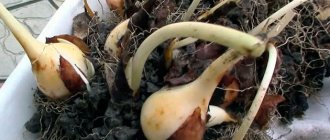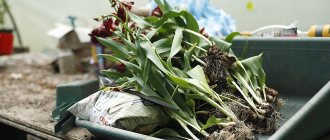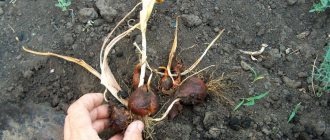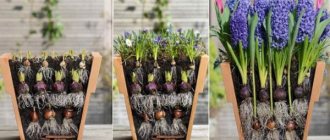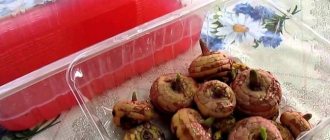Biological feasibility of excavation
Removing tulip bulbs from the ground is a biological need of the plant. The old bulb dies, leaving behind a family of daughter bulbs (babies). Next year the division process will be repeated, and the conditions for the normal development of tulips will worsen: the lack of nutrition and space will make itself felt. The flowers are crushed and will begin to degenerate.
The bulbs require good heating in order for flower bud formation to occur. If flowers are not dug up, next year they may lose their decorative value due to lack of heat.
Digging for the winter allows you to prepare the soil: fertilize, add sand and peat, improve soil fertility, remove weed rhizomes without causing damage to the tulips. If dug up bulbs are cleaned of remnants of scales and dead ones are removed, you can reduce the risk of infecting flowers with pest larvae and fungal diseases. In addition, it is useful to treat planting material annually with a solution of potassium permanganate or Fundazol.
Bulbs that are not removed from the ground for the winter become deeper over time. From there it is difficult for the sprout to break through to the surface, and there is a lack of heat for bud formation. Therefore, digging up and storing tulip bulbs before planting is a good way to speed up the propagation of valuable varieties.
Tips for proper storage
With some effort and following simple storage rules, it is quite possible to preserve tulips at home before planting them in the ground.
Tips on how to save planting material
- When removing from the ground, the bulbs should be handled very carefully so as not to damage them. Violation of the upper protective layer will increase the possibility of infection with fungal diseases.
- For storage, it is optimal to use a wooden box, since it is difficult to ensure good air circulation in cardboard boxes, moreover, they become damp and can become a breeding ground for bacteria and fungi.
- To protect against excessive moisture, it is recommended to sprinkle the planting material with sawdust.
- The material should be laid in one layer so as not to impair ventilation.
- If the house has a basement, then the seed material can be laid out directly on a dry shelf and the air temperature can be constantly monitored.
- When growing bulbs in an apartment, you can place them in wooden boxes and store them on the balcony, monitoring the temperature inside the container with a thermometer.
- When professionally growing flowers, a heat chamber is used to maintain the temperature within the required limits.
- In some cases, you can store the material in the lower compartment of the refrigerator, where the temperature ranges from 3 to 5⁰C.
The health and further development of flowers after planting in the ground will depend on how accurately these recommendations are followed.
Rules for preparation for storage
It is best to dig up flowers in dry, but not hot weather. Work should be carried out carefully so as not to cut them with a shovel. Freshly dug tulip bulbs must first be dried. To do this, you can use any place with good air exchange, but protected from the sun: attic, veranda, canopy. There the onions are laid out in one layer to dry.
After 2–3 days, the bulbs are sorted, cleaned of soil, remnants of covering scales and roots, and then treated with a solution of potassium permanganate or contact fungicides. This will prevent the development of fungus or rot. After the preparation has been completed, the future seed is stored.
When to remove the bulbs
The bulb ripens within one month after the tulips bloom. At this time, the above-ground parts of the plant begin to die, and there is an outflow of useful substances from them. The scales of the bulb darken, acquiring a brownish tint.
Tulips can be removed when ⅔ of their leaves have withered and the stem itself has softened and turned yellow. For central Russia, this period corresponds to the last ten days of July. Tulips can be considered ready to be removed from the ground if their stem can be wrapped around your finger.
Advice
Do not dig up tulips ahead of time. In this case, the replacement bulbs do not have time to form a protective shell and fully ripen, as a result of which they become smaller and are susceptible to fungal diseases. Most of this inferior material will not survive to be planted in the ground, and good flowering should not be expected from those that survive.
It is also undesirable to delay removing the bulbs until the above-ground part of the plant has completely dried. In this case, it is sometimes impossible to determine their exact location, and the nests of the bulbs are destroyed, which leads to the loss of a large amount of material.
When to dig up tulip bulbs
When deciding how often to dig up tulips, take into account that if you leave the bulbs for several years, they become smaller, and the plant begins to reproduce worse. If you grow tulips without annual digging, the plant does not receive enough nutrition due to a decrease in area, and the bulbs are more often affected by diseases and pests. Experienced flower growers advise digging up tulips every year. Only varietal tulips with small bulbs can be left in the soil for two years. You can start harvesting tulip bulbs when their leaves turn yellow and the covering scales turn light brown. Some gardeners determine the “readiness” of the bulb for digging in the following way: wrap the end of the stem in a ring on your finger - if this is done easily, then the bulbs are ripe.
It is important to dig up tulips in a timely manner. If you rush into harvesting, the bulbs will turn out to be immature, with insufficiently formed integumentary scales. Such bulbs are poorly stored; they are more susceptible to mechanical damage and fungal diseases. Early digging causes a decrease in the number of children and loss of the decorative qualities of the plant. However, you cannot be late with harvesting, since it is difficult to find the bulbs. The nests of bulbs become overripe and have time to crumble, so small children remain in the soil and are partially damaged by a shovel, and this leads to infection with diseases. Tulips are dug from late June to mid-July. When digging, the bulbs are immediately sorted by variety and ripening period, culling and destroying diseased and ungerminated specimens.
Preparing bulbs for storage
The extracted nests of bulbs, without removing soil and scales, are placed in baskets or other ventilated containers and dried in a dry and warm place for a week. For these purposes, a veranda, gazebo, shed, or ventilated shed will do. In this case, it is necessary to avoid damage to the material by direct sunlight.
After a week, the tulip bulbs are cleaned of roots and covering scales, rotten or damaged ones are removed, and the remaining ones are sorted by size. Minor damage is removed with a sharp knife and washed. Then the planting material is treated with a solution of sodium permanganate or contact fungicides to protect against rot and fungus.
How to store tulip bulbs until autumn
After digging, the bulbs must be dried in the shade, preferably in a draft. This will take from two to 10 days, depending on weather conditions and soil moisture. After drying, you will need to do the following:
- shake off the ground;
- remove those integumentary scales that themselves have begun to peel off;
- trim old dried roots;
- sort the onions by size.
Clean sorted seed material is placed in cardboard or wooden boxes. And they are sent to a dry and warm place before autumn planting.
As a rule, small onions will not bloom next year. They should be planted for growing somewhere in a sunny place.
Large and medium-sized ones are planted in flower beds and flower beds. But at different depths: the larger ones are deeper.
The use of special baskets for bulbs will make the work of both planting and digging much easier. We have already talked about them... Firstly, this way the onions will not “run away” into the depths. Secondly, after the tulips bloom, the basket can be pulled out of the flowerbed. Send to a secluded corner for ripening, and plant summer plants in place of the basket.
Storage conditions
The most important conditions for storing material are stable temperature, good ventilation, low humidity and absence of light. It is best to store tulips in natural wicker baskets, wooden boxes or on shelves, in paper containers or nets suspended from the ceiling.
The sorted material is laid out in containers in one or two layers. Over the next two months, the formation of buds and leaves occurs in the bulbs, so the planting material should be provided with optimal conditions.
- Humidity should be between 60-70%. Dry air can lead to wrinkling of the fleshy shells of the bulbs, and excess moisture promotes early germination and proliferation of putrefactive microorganisms. When the material wrinkles, you should slightly humidify the air in the storage.
- Ensuring the correct temperature conditions is the main condition for saving material. For the first three weeks of storage, the temperature must be maintained at 25-30⁰ C. The rest of the time – no higher than 15-20⁰ C.
- One of the main storage conditions is to ensure ventilation in the storage. Do not store bulbs in plastic containers with high sides or plastic bags. In such conditions, the material will not survive until planting.
In conditions of high humidity and unstable temperatures, inspection of the bulbs should be carried out regularly. Material affected by rot should be discarded. The refrigerator is not the best place to store bulbs. Low temperature inhibits bud formation. The bulb will keep well, but the plant will not produce flowers.
Adult bulbs become smaller from year to year and degenerate, so children need to pay maximum attention. They must be stored at 20 degrees, inspected and ventilated.
Advice
If there is a risk of damage to tulip bulbs by rodents, then it is optimal to store them in nets or stockings suspended from the ceiling.
When is the best time to plant
Unlike other types of ornamental plants, it is better to plant tulips in the fall. The optimal time for this event is the second and third ten days of September or the first week of November. During this period, the soil at a depth of 15 cm has a temperature of 10 to 13⁰ C.
This is interesting: Climbing rose Parade with silk flowers of burning pink color
Cooling during this period stimulates the plant to form sprouts and lay buds. Plants of the bulbous family cannot bloom without pre-cooling. Timely planted material has time to take root and tolerates frost well. If tulips are planted in the ground after the top layer of soil has frozen, then the planting should be well covered with brushwood, peat or other insulation.
Existing methods for storing bulbs
If you do not have time to plant the material on time, you can use one of the proposed options for storing the bulbs. The most important condition for winter storage is stratification, otherwise the plant will not produce flowers after planting.
- Wet germination
An excellent storage option would be wet germination of tulip bulbs. To do this, place wet sawdust or high-moor peat in a plastic perforated container. The bulbs are placed on it bottom down and lightly sprinkled with substrate. Containers with tulips should be stored in the cellar. Plants germinated in this way begin to bloom at the usual time.
- Dry storage
If you have a small number of tulips, you can store them in the vegetable drawer of the refrigerator. In this case, each onion should be wrapped in a paper sheet.
A good place to store tulip bulbs is the basement. In order to create optimal conditions for the plant, you need to sprinkle the material with dry sawdust or sand. Plants planted in spring begin to bloom later than usual.
- Early forcing
If the material is unlikely to be preserved until spring in the usual way, you can do early forcing and then grow it in open ground. Plant the bulbs in containers with regular soil from the garden. Until the first frost, they can be stored on the veranda or balcony, and then covered with polyethylene and lowered into the cellar. Ventilate every 2 weeks, moisten the soil as needed. After the sprouts appear, the containers are exposed to light.
Storing tulips in winter
Storing tulip bulbs in the refrigerator
Regardless of how you store tulip bulbs in winter, first carry out stratification - cooling the material at a positive temperature close to 0 degrees: store the bulbs for 2-3 months where it is cool. If you ignore this procedure, the plants will not bloom in the spring. Find out how to store tulip bulbs at home:
| Dry storage | Wet storage | Early forcing |
|
|
|
Preparing for landing
Regardless of the time of planting, pre-treatment of the material should be done before planting. It is identical to preparing the bulbs for storage.
Processing of planting material includes several stages:
- cleaning bulbs from scales;
- inspection and sorting;
- disinfection;
- processing of material with minor defects.
If the process of preparing tulip bulbs for planting seems labor-intensive, you can purchase ready-made material in the store, which is processed in accordance with all standards. In this case, you need to buy high-quality bulbs from a reliable large supplier.
Thus, tulips require annual digging and appropriate treatment. The process of proper storage includes drying, warming and disinfecting plant bulbs, which, in turn, stimulates the formation of flower buds. Planting material that has undergone proper storage and processing produces good flowering and growth of young bulbs for propagation of the variety.
There are different views on the advisability of digging up bulbs. Some gardeners recommend removing and drying tulips not every year, but periodically, but the experience of famous breeders suggests that it is better to do this annually.
Catherine
Post published: 11/21/2016
Post was modified: 11/21/2016
Preparing tulip bulbs for storage at home
To preserve until the next planting, they are dug up at the end of June, when the leaves wither and turn yellow.
The preparation for storage procedure takes a certain time:
- The dug up tubers are cleared of soil , sorted by variety and size, and placed in different containers. The varieties are signed.
- Large specimens are set aside separately, which can be used for forcing.
- Unbroken nests are separated manually .
- Small babies with a diameter of less than 1 cm are discarded - it will take at least 2-3 years to grow them.
- Dispose of sick and damaged ones.
- The planting material is etched with a weak solution of potassium permanganate for 20-30 minutes.
- The bulbs are dried for several days in a well-ventilated room or outdoors under a canopy - they should not be exposed to precipitation or sunlight. When drying, the planting material is laid out in one layer.
- The dried ones are sorted again, the covering scales and the remains of roots and stems are removed.
At this point, the preparation is considered complete, and the tulips are stored until spring.
Preparing for storage after digging
When to plant tulips
Compliance with planting dates plays an important role in growing this crop. Planting too early may cause the bulbs to sprout prematurely, which will be damaged if frost occurs. If they are planted late, full rooting will not occur, which means that flowering in the spring will occur later. The determining factor for planting is the soil temperature at a depth of 15 cm. By the time the bulbs are planted, it should be 8-10°C. It takes 20-25 days for the roots to grow thoroughly in the soil. The air temperature at the time of planting is usually around 0°C or slightly higher.
Planting tulip bulbs
Recommended timing for planting tulips by region:
- Middle zone - from early September to early October;
- Siberia - from late August to early September (a little longer in warm weather);
- Middle Urals - mid-September, Southern Urals - early October;
- Stavropol Territory, Crimea, Kuban - towards the end of October.
Important! In Ukraine, tulips are planted in the fall in the same numbers as in the south of Russia. The timing for Belarus coincides with the timing of the Middle Zone.
It is also worth ensuring proper soil preparation and proper planting. Heavy clay soil must be made permeable and nutritious by adding sand, peat, and rotted manure. The acidity of the soil must be adjusted so that this parameter is in the range of 6.5-7.8 pH. You can acidify the soil by adding peat; wood ash or limestone will help neutralize the acidity. Sandy soil is well seasoned with compost and mineral fertilizers.
Note! Fresh manure should not be used to feed bulbous crops. This causes plants to burn their roots and cause fungal diseases.
The dug up soil is leveled and furrows are marked for planting tulips. They should be shed for disinfection with a solution of potassium permanganate. For large bulbs, dig holes 8-12 cm deep at a distance of 12-15 cm from each other. Small nodules are planted denser and closer to the surface.
In light soil, the bulbs can be buried a little more, but in heavy soil, vice versa. Before planting in an area where water stagnates, a sand cushion is laid out at the bottom of the hole or a handful of expanded clay is poured. It is advisable to dust the bulbs with wood ash, this will give them additional protection. When planting, they are lightly pressed into the ground so that there are no air pockets underneath them, and then watered.
Important! If the planting material is not uniform in size, you can make the hole slightly wider, place a large onion in the center, and several small ones around it.
After planting, the holes are sprinkled with fertile soil and the surface is leveled so that water does not stagnate in the flowerbed during the autumn rains. If there is no rain within the next 5-7 days, the plantings need to be watered, otherwise the roots will not grow well. To keep your flower bed bright in the spring, you can plant tulips with different flowering periods in one place or place other early flowering plants nearby.
In the northern regions, after planting, tulips are mulched with peat or compost; the layer thickness should be about 4 cm. In the spring, the mulch is not removed from the flowerbed, as it prevents the appearance of a hard crust on the soil surface, which delays the emergence of sprouts and the penetration of moisture to the bulbs. If winters are too cold, you can add an additional layer of straw on top after the soil has completely frozen.
This is interesting: How can you feed peonies after flowering: the best homemade and mineral fertilizers
For your information! Many gardeners have adapted to growing tulips in plastic baskets with a lattice bottom. This planting allows you to quickly and easily form a flower bed and remove nests from the ground without fear of damaging the bulbs. An additional benefit of this method is that the plastic prevents rodents from reaching and damaging the tubers.
Tulips, earlier than many other flowers, begin to delight summer residents with bright buds and give them a spring mood. The abundance of varieties makes it possible to build spectacular and original compositions. Proper storage of the bulbs of this crop allows you to later enjoy its beauty.
Digging up tulip bulbs for the summer ensures their safety and lush flowering next year. This procedure is especially important for modern hybrids. However, tulip bulbs must be stored in suitable conditions, strictly following a number of rules, otherwise digging them up will only damage them.
Storage methods until spring
Gardeners use several methods for storing bulbs, depending on living conditions and personal preferences. Of course, it is best to plant flowers before winter and cover them with spruce branches, straw, tops or snow, where they are left until spring.
When planted in winter, flowers take root better and bloom earlier. But if it is not possible to plant the bulbs in the garden in late autumn, you need to create special conditions so that they remain viable until spring.
Covering tulips with spruce branches for the winter
Regardless of the method, a certain temperature regime is required .
In July, the temperature should be +23+25°C - this is necessary for laying a flower bud for next year. In the following months, the temperature should drop: in August to +20°C, in September-October to +15°C, in winter a drop to +10°C is permissible.
In boxes
Most often, wooden or plastic boxes . Containers with a lattice bottom or walls are especially good - they will provide good ventilation and prevent the process of rotting.
Experienced gardeners do not recommend using : cardboard quickly absorbs moisture from the air and becomes covered with mold, which is dangerous for the bulbs.
Planting material is placed in boxes in two ways:
- A layer of sawdust is poured into the prepared boxes , and a layer of bulbs is placed on top. When there is a large amount of planting material, alternate a layer of sawdust and tulips. Sawdust will act as a hygroscopic material and remove excess moisture from the surrounding air.
- Each is wrapped in newspaper or thin wrapping paper and placed in a box.
The boxes are installed in a dry, cool, well-ventilated place. Instead of wooden or plastic containers, some summer residents use fabric bags or nylon tights: tulips are placed in small batches in rag containers and hung from a crossbar.
In the cellar or basement
You can save it until spring planting in another way. Owners of a dry basement or cellar store tulips in the ground :
- Light, neutralized soil is poured into a wooden or plastic box, obtained by mixing garden soil with peat and vermiculite and steamed for an hour in a water bath.
- Bulbs are planted in the prepared soil, which take root, but do not begin to grow until spring due to the cool temperature.
Storage in boxes with soil
In an apartment
In an apartment, the most difficult thing is to find a suitable storage space. Some varieties of tulips can be stored in the refrigerator at a temperature of +5°C . However, it is more advisable to find a warmer and drier place of detention - this could be an unheated storage room or a glazed loggia.
In any case, the storage location should be away from heating devices and protected from drafts.
Storing tulip bulbs in the refrigerator
Proper preparation of planting material for storage and compliance with basic requirements will allow you to preserve the bulbs until planting with virtually no losses. All efforts will be rewarded in the spring, when bright, cheerful tulips bloom in the flowerbed or garden bed.
Digging up tulip bulbs for the summer ensures their safety and lush flowering next year. This procedure is especially important for modern hybrids. However, tulip bulbs must be stored in suitable conditions, strictly following a number of rules, otherwise digging them up will only damage them.
How to dig up tulip bulbs - procedure
The day you are going to dig up tulips after flowering should be sunny and warm. The soil in the flower garden should be dry. They dig up the flower with a pitchfork, moving further away from the stem in order to capture all the tulip children with a clod of earth.
Advice. In gardening stores you can purchase special baskets for bulbous plants. The basket is dug into the soil, tulips, daffodils, hyacinths and crocuses are planted in it. The resulting baby remains in the container, which makes it easier to collect.
Proceed as follows with dug up tulips:
- The soil from the roots and tubers of the flower is shaken, the stems and leaves are cut off.
- The bulbs and babies are left to dry in the garden for a couple of days or put in a dry, ventilated room.
The bulbs are separated from the roots and sorted by size. At the same time, diseased specimens with traces of mold, brown spots, and cuts are selected. If a healthy onion is damaged by a shovel or pitchfork, the wound is cleaned and generously lubricated with iodine, brilliant green, or sprinkled with ash (wood ash).
To disinfect the bulbs and destroy invisible spores of fungi and viruses, planting material is kept in a saline solution for half an hour:
- 1 liter of warm water,
- 1 tablespoon salt.
To enhance the effect, you can add a teaspoon of baking soda. You can use a bright pink solution of potassium permanganate or Fitosporin.
Store tulip planting material for about three to four weeks in cardboard boxes, scattering the tubers in one layer. Storage temperature from +20 to +25 degrees, humidity about 70%. Preserved tubers do not require light.
Important! Don't forget to label boxes with varietal tulips to avoid confusion!
A common mistake made by novice gardeners is digging up tulip bulbs early. Yellowing leaves do not color the flower garden, and the beginner begins cleaning, trying to preserve the decorativeness of the flower bed. This is mistake.
When planting tulips, it is necessary to foresee in advance the possibility of decorating fading foliage. To do this, annual seedlings are planted among primroses, or the flower bulbs themselves are placed among late-blooming perennials (peonies, daylilies) so that their leaves hide the fading tulips.
It is wrong to trim the leaves of a flower after flowering has ended. From the fading tops there is an outflow of nutrients into the tulip bulb. An infection can penetrate into the bulb through wounds on cut leaves. But it is useful to remove faded buds from the flower stalks so that the plant does not waste energy on producing seeds.
Important! Immediately after flowering, tulips need to be fed with a solution of phosphorus-potassium fertilizer for better bulb formation. The concentration of the solution is made twice as weak as usual.
If the tulip bulbs were dug up early, their tuber did not “dress”, but the foliage remained juicy and green, there are several ways to correct the situation.
- You can return the plant to the ground and wait for the foliage to naturally wilt and turn yellow, then dig up the bulbs and dry as usual.
- You can do the same with the bulbs as with mature flowers - put them in storage. According to reviews from flower growers, both options show good results in the survival of tulips.
Is it possible not to dig up tulips for the winter?
Beginning flower growers often worry about the safety of rare and expensive varieties of tulips in frosty and harsh winters, fearing they will freeze, and want to know when to dig up tulips for the winter. However, it is extremely difficult to preserve dug up bulbs at home during the winter, so they are not removed from the ground for the winter.
Preserve flower plantings from frost by covering the flower bed with agro-fabric, spruce spruce branches, and peat.
Important. The flowerbed is not insulated with straw or plant debris, since mice are easy to breed in such a shelter - they are big hunters of flower bulbs.
Experienced gardeners preserve especially valuable specimens of bulbous plants in pots. When planting tubers in the fall, not in the ground, but in a spacious pot with loose, nutritious soil. With the onset of frost, dishes with flowers are put away in the cellar until spring.
Thus, you can prepare tulips for winter or early spring forcing for flowering at home. A couple of weeks before the desired flowering date, the pot with the tulip is taken out of storage, brought into a warm place, and watered. With good care, the plant will bloom no worse than in open ground.
Do I need to pick the flower to get a good bulb?
You can often see vast clearings of tulips, or more precisely, their leaves, in abandoned gardens. Without proper care and regular drying, the plant's bulbs gradually become smaller and a lot of babies are formed. The flower spends all its energy on maintaining the life of new bulbs, and there is no longer any left for flowering.
Advice. If a florist is faced with the task of obtaining high-quality planting material, the tulip is not allowed to bloom. The bud is removed as soon as it begins to fill. The forces that the flower would spend on flowering will be used to form a strong and full-bodied onion.
Simple or “wild” tulips can maintain their decorative properties for several years without being dug up. Modern beautiful varieties with unusual colors and glass shapes will not bloom without annual drying.
When to dig up tulips and how to do it correctly.
Video
In the following videos, an experienced gardener talks about the rules for digging and storing bulbs of different varieties of tulips:
Journalist by training, author of short stories. He loves mountains, grows garden and indoor flowers, and collects hyacinths. A special pride is a small “plantation” of coffee trees. She is interested in landscape and interior design and tries to bring her favorite ideas to life.
Found a mistake? Select the text with the mouse and click:
Oklahoma farmer Carl Burns developed an unusual variety of multi-colored corn called Rainbow Corn. The grains on each cob are of different colors and shades: brown, pink, purple, blue, green, etc. This result was achieved through many years of selecting the most colored ordinary varieties and crossing them.
The homeland of pepper is America, but the main breeding work on developing sweet varieties was carried out, in particular, by Ferenc Horvath (Hungary) in the 20s. XX century in Europe, mainly in the Balkans. Pepper came to Russia from Bulgaria, which is why it received its usual name - “Bulgarian”.
One of the most convenient methods for preparing a harvest of vegetables, fruits and berries is freezing. Some believe that freezing causes the nutritional and health benefits of plant foods to be lost. As a result of the research, scientists have found that there is practically no decrease in nutritional value when frozen.
Natural toxins are found in many plants; Those grown in gardens and vegetable gardens are no exception. Thus, the seeds of apples, apricots, and peaches contain hydrocyanic acid, and the tops and peels of unripe nightshades (potatoes, eggplants, tomatoes) contain solanine. But do not be afraid: their number is too small.
Compost is rotted organic remains of various origins. How to do it? They put everything in a heap, hole or large box: kitchen scraps, tops of garden crops, weeds cut before flowering, thin twigs. All this is layered with phosphate rock, sometimes straw, earth or peat. (Some summer residents add special composting accelerators.) Cover with film. During the process of overheating, the pile is periodically turned or pierced to bring in fresh air. Typically, compost “ripens” for 2 years, but with modern additives it can be ready in one summer season.
Both humus and compost are rightfully the basis of organic farming. Their presence in the soil significantly increases the yield and improves the taste of vegetables and fruits. They are very similar in properties and appearance, but they should not be confused. Humus is rotted manure or bird droppings. Compost is rotted organic remains of various origins (spoiled food from the kitchen, tops, weeds, thin twigs). Humus is considered a higher quality fertilizer; compost is more accessible.
Tomatoes have no natural protection against late blight. If late blight attacks, any tomatoes (and potatoes too) die, no matter what is said in the description of the varieties (“variety resistant to late blight” is just a marketing ploy).
“Frost-resistant” varieties of garden strawberries (more often simply “strawberries”) need shelter just as much as ordinary varieties (especially in those regions where there are snowless winters or frosts alternating with thaws). All strawberries have superficial roots. This means that without shelter they freeze to death. Sellers’ assurances that strawberries are “frost-resistant,” “winter-hardy,” “tolerates frosts down to −35 ℃,” etc. are deception. Gardeners must remember that no one has yet managed to change the root system of strawberries.
From varietal tomatoes you can get “your own” seeds for sowing next year (if you really like the variety). But it is useless to do this with hybrids: you will get seeds, but they will carry the hereditary material not of the plant from which they were taken, but of its numerous “ancestors”.
How to store tulip bulbs in winter: stages of work and conditions
Blooming tulips are a decoration for any flowerbed and a guarantee of a good mood for the owners of the site. Most gardeners know that the annual digging of these flowers is an obligatory stage of agricultural technology and the key to their prolific flowering in the coming season.
Simple types of tulips successfully “winter” in open ground if the bulbs are planted in September-October. But for capricious flowers it is difficult to create natural conditions under which they can accumulate their potential and not lose varietal characteristics. This is where the responsible gardener faces the question of how to store tulip bulbs in winter.
This is interesting: Castor oil for flowers - what is the secret of feeding. How to make fertilizer with your own hands
What if you don’t dig it up?
Annual digging allows you to select the highest quality material, preserving valuable species properties for the next harvest.
The exception is simple varieties of tulips, which perfectly “tolerate” autumn bad weather and winter cold, and in the spring they delight with selected and juicy buds.
But it is recommended to dig them up periodically (once every 2-3 years) to “regenerate” and “renew” the varietal stock.
It should be borne in mind that the more exquisite the flower, the more attention it will require from the gardener in comparison with an ordinary (varietal, not hybrid) tulip.
Ignoring the recommendation to dig up bulbs every season can lead to the following problems:
- grinding seed material. The mother bulb dies after the end of the vegetative period, but gives life to numerous children. If the entire family is left annually in the ground, then the area allocated for one full-fledged bulb will accommodate several small specimens. Over time, tulips weaken and stop forming large, beautiful heads;
- burying the bulbs in the ground. As a result, it is difficult for young shoots to “get out” to the surface of the earth in time. In addition, the grower himself can forget over the winter where his tulips are, not finding any bulbs in the top layer, and sow the area with something else or destroy the sprout that has just “hatched” when digging up;
- damage and rotting of bulbs. Annual inspection and rejection of spoiled tulips reduces the risk of pests and diseases.
- loss of varietal properties. Weak specimens will not produce viable children.
Storing tulip bulbs at a certain temperature and humidity is the key to luxurious spring flowering.
Time to collect bulbs: when and how
You can dig up tulips after the first two leaves have already turned completely yellow, and the end of the dried stem can be wound around your finger. This usually happens in mid-June, but if you are late, you will have to catch up in the first ten days of July. The exact harvesting time depends on the vegetative characteristics of the individual variety and weather conditions.
You cannot wait until the plant dries completely, as after this it will be difficult to find where the tulips are “hiding”.
In addition, the mother bulb falls into pieces after the stem withers, and small children often go unnoticed and “overwinter” in the soil, which increases the risk of them becoming infected with various diseases or pests.
It is recommended to dig when the leaves become soft and pliable, and the stem turns yellow and dries out.
Timely and annual digging is the most important element of agricultural technology, ensuring excellent storage of tulips not only until the autumn planting in open ground, but throughout the winter.
How to prepare seed for storage
After digging, tulips with overgrown old roots and lumps of earth are laid out to dry under a canopy in a warm but well-ventilated place. A covered veranda, barn or gazebo is suitable for this. You need to try to protect the seed from precipitation, bright sun and drafts.
A week later, the dried bulbs are cleaned of covering scales and old roots, the adhering soil is scraped off with a knife, and minor defects (ulcers, growths, mold) are removed. Critically damaged or rotten specimens are thrown away. The nests are disassembled into segments and all seeding material is sorted by size and variety.
Selected bulbs should be scattered in 1-2 layers to dry on paper folded in several layers and placed in a cool, ventilated place in the house (apartment), and not outside.
Knowing how to store tulip bulbs, even an inexperienced gardener can avoid losing quality seed.
Methods for storing tulips
Tulips are usually planted in the fall, before frost. But sometimes it is impossible to land due to weather conditions. Therefore, there are 2 ways to store these plants:
- for autumn planting;
- planting bulbs for the winter.
Rules for autumn storage
After final drying, the prepared tulip bulbs are stored. It should be taken into account that they need to be provided with comfortable conditions. Thus, it is recommended to maintain the temperature at +23-25 ˚С at the end of summer, reduce it to +20 ˚С in September, and bring it to +15 ˚С by October.
A small collection of tulips is stored in the bottom drawer of the refrigerator, scattered at the bottom in 1-2 layers. To ensure the survival of the most valuable specimens, it is recommended to carefully wrap the bulbs in paper and place them in the chamber as such.
Tulip bulbs: how to store
Holland is considered the birthplace of tulips, but in fact the flowers came from the East and simply became widespread in the European country. In Holland, special technologies have been developed for the extraction of planting material, as well as storage.
Blooming tulips are harbingers of spring, which must be planted according to the rules
Naturally, a cheaper savings option is used at home. This does not require special devices or equipment. In order for the flower beds to be in bloom in early spring, you need to worry about preparing the compositional components in advance. You need to know how to store tulip bulbs and save them before planting.
How to preserve flower material before planting:
- Cut off the top of the plant to prepare the underground element.
- Remove the bulbs from the soil at the appropriate time, when the material is already ripe.
- Lay out to dry each piece.
- Remove excess husks and cut off roots.
- Treat with a special product to protect against pests and diseases.
- Prepare containers and auxiliary materials for arranging the storage space.
- Choose a place to save.
Collected planting material
In order to accurately preserve the extracted part from the ground until planting, you need to organize the correct conservation conditions and perform each procedure on time and correctly.
Storing tulip bulbs after digging until planting in the fall
It is necessary to remove the bulbs in time. This is usually done at the end of July. The timing may vary in different regions, so it is better to focus on other indicators. But there are several external factors by which you can determine the exact time of the procedure:
- You can dig up tubers when the aboveground part loses about 2/3 of the leaves;
- if the stem becomes so soft that you can wrap it around your finger without any problems, then it is the ideal time to remove it;
- When the above-ground part has completely withered and changed color to yellow, you can begin to select the bulbs from the soil.
Note! Extraction is carried out in accordance with the following technology. You need to carefully dig up the place, select the bulbs and not remove the earthen ball at first.
After digging, you need to properly prepare the planting material for conservation before planting it in open ground. This is done in the fall, since in early spring the plants are already preparing for flowering.
Storing tulips after removing the material from the ground:
What does a plant look like when it's ready to be dug up?
- After drying, it is recommended to treat each element with a special product that will prevent the appearance of mold, mildew, and pests.
- Place the material in containers that allow air to pass through well. These can be plastic or paper devices with holes in the body.
- Retail storage is encouraged, when each copy is fenced off from others. You can use newspaper to wrap each bulb. If you use a paper container for eggs, then it is advisable to sprinkle each cell with sawdust.
- It is necessary to ensure a stable level of humidity. The norm is considered to be a humidity of 60-70%. If this indicator is lower, the material will begin to dry out, and if carried away, it will rot.
- The temperature regime should be constant, the indicators should not change during the storage period. The first month the temperature should be 25-30 °C. The rest of the time - 15-20 °C.
- Every day you need to ventilate the storage area. 5-10 minutes is enough. to carry out the procedure.
Storage containers
Important! The ideal place to store high-quality tulip planting material is the refrigerator. You must first set the correct temperature and humidity settings. An alternative could be a cellar or barn.
Processing tulip bulbs after digging
You need to carefully dig up the tubers and lay them out on a flat surface to assess the condition of each specimen, select damaged ones, and trim off damaged parts. To prevent further deterioration of the condition of the tubers, it is necessary to carry out treatment with special means. What you can use:
- a weak solution of manganese will be the simplest option that even a novice gardener can implement;
- you can prepare a solution of karbofos and water, spray the laid out specimens and wait for complete drying;
- More experienced gardeners usually soak the bulbs in water. You need to heat it to 50-40 °C and pour over the bulbs for 10 minutes, then dry and remove.
Potassium permanganate solution for treatment
There are also more complex homemade recipes suitable for processing. Some suggest multicomponent solutions with specific components, so it is not always advisable to use them.
In order to grow healthy specimens in the future, it is recommended to carry out pre-treatment with special means. The same procedure should be done before direct planting in open ground.
How to dry tulip bulbs
Drying planting material involves several sequential steps that are simple. In this case, there is no need to create any special conditions for the location of the tubers. You need to prepare a paper base and choose a room that does not receive direct sunlight. How to properly dry a flower “harvest”:
- Pull out the tubers very carefully, do not remove soil and scales from the surface of the bulbs. If this is done right away, then microbes from the soil can penetrate under the skin and begin to develop there, which will lead to their spoilage.
- After digging, lay the specimens on newspaper or sheets of paper. It is necessary to arrange drying in a room with good ventilation, but without direct sunlight. The temperature can be any, but the humidity should remain within 70%.
- A week after the main drying, you should go through the material: cut off the roots, clean off the exfoliated scales, throw away rotten and damaged specimens.
- Treat with a special agent that will destroy more persistent pathogens.
- After spraying, you need to re-dry, which may still take from 1 to 5 days.
Drying option
Only after such a set of measures can you prepare to harvest tubers for a long time. Therefore, drying is an important preparation condition. Then storage can be extended throughout the winter.
